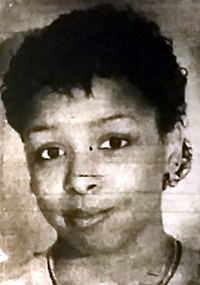|
Republished with permission granted by The Washington Newspaper Publishing Co. LLC d/b/a MediaDC. Back to Montgomery Journal articles
LaShawn Haythe still hasn't hit top speed
 Special to the Journal Special to the Journal
After topping a quality sprint field in winning the National Guard meet girls 55-meter dash, Gaithersburg junior LaShawn Haythe displayed some disappointment with her performance. She said she wasn't in top form and it wasn't anyone's fault but her own.
Her coach, Fran Parry, agreed. "She didn't even come out in the fall, she just sat around," Parry said after the meet. "Her form is terrible, but we're working on it."
Last year Haythe joined Gaithersburg's sprint crew and demonstrated outstanding talent. As a sophomore she won the indoor class AA Region I 55 meter dash and placed in the finals of the state meet. Outdoors, field Coach Fred Joyce began teaching Haythe the fundamentals of the horizontal jumps and she competed in those events during the regular season. At the end of the season Haythe finished third in an outstanding AA state 100 meter sprint final.
Her future appeared bright and secure. But, said Parry, her summer running, instead of helping, became a hindrance.
The problem, he said, is that she didn't have tough enough competition in her teeny bopper club to improve.
"In the summer, she has success against girls her own age or younger, but she's got to give up teeney bopper running...She's above teeney bopper running, she's out of that level."
Parry is very optimistic about Haythe's future in track, but his optimism is conditional - she has to give up gearing toward her summer program. A comparison can be made to tennis in this instance. Burgeoning tennis stars are told they'll never excell unless they play against those of superior ability.
"We feel very strongly about LaShawn's potential if she lets go," Parry said. "She's her own worst enemy in regards to working out. I think she wants to put out, but someone tells her, and I don't know where she's getting her information, that she can't because she has to run summer. She uses the academic year to train for summer and she works with whoever she does in the summer and they tell her they're going to do it their own way. It's hard to break through that.
"They'll be no help in getting financial aid and college is one of the reasons for her running. She's moving towards that goal. But we'll work on that."
Parry approaches high school track as a multi-year commitment once the student joins the team and expresses a desire to excel in track and field. The athlete's initiation to track at Gaithersburg is a session with Parry in which coach and runner plot a course to achieve seasonal goals as well as an ultimate goal by the end of the runner's high school career.
"My goal indoors is to improve my time," said Haythe, 16. "For the future I want to go to the Olympics. That'll take hard work. I also want to get a college scholarship, but I haven't thought about where I want to go."
Parry adds technique improvement to Haythe's list of immediate goals. He explained patiently to a non-sprinter that after reaching maximum speed at about 40 yards, most every sprinter decelerates around 60. The better sprinters don't decelerate after 60 and deceleration is a function of conditioning and technique. At National Guard Haythe began decelerating at mid-race. He adds that, "inefficient technique ties you up, you lose ground, there are too many countering movements."
It's easy to visualize the affect numerous conflicting movements acting against each other have on a sprinter attempting to run a straight line when Parry describes Haythe's latest technique. "When she left us last spring, she was using our technique, which is as efficient as possible.
"LaShawn came back this winter with horrendous arm movement, they cross her body below her waist. Her head leans back, she's got bowed back, her hips roll. Everything we worked on all last school year vanished. Now some of that comes from lack of conditioning, no cross country. She ran all summer and I guess she wanted a break between seasons. Even in easy intervals she still uses antique technique. It's counter efficient.
"She can feel it, though. I run with them in their workouts, I'm right at their ends yelling at them. She's out of sync, but she's improving. She just needs more work."
Yet with all the evidence against it, Haythe, 5-2, 105, still professes an allegiance to summer track, an age group program where runners compete only against those of their own age and, in most cases, of similar talent level.
"Summer track is more important, we go different places," she said. "I won at some big meets, some of the junior olympic meets this summer. At the East Coast Invitational (last July) I got fourth or fifth in the 100 and fourth or fifth in the 200."
But, as Parry is fond of saying, he's working on that.
|